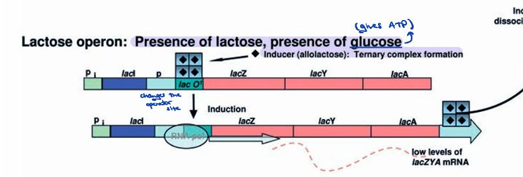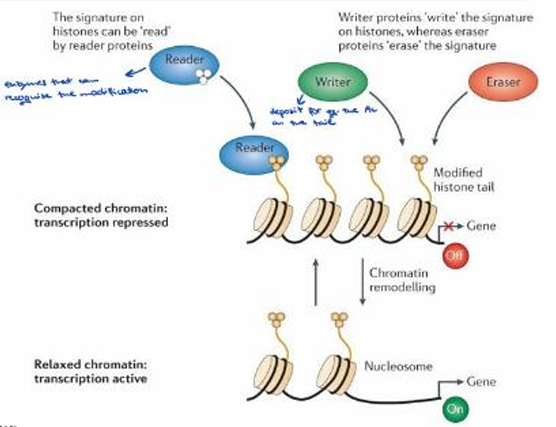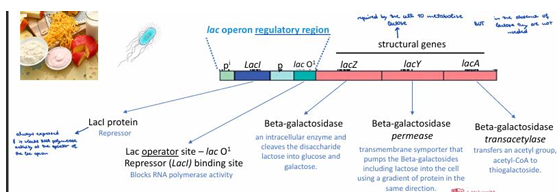10 Control of Gene Expression
1/28
There's no tags or description
Looks like no tags are added yet.
Name | Mastery | Learn | Test | Matching | Spaced |
|---|
No study sessions yet.
29 Terms
What is the primary way a cell regulates its viability and various cellular processes?
A cell primarily regulates its viability and cellular processes by modulating gene expression.
Who first proposed the concept of a molecular switch that could enhance or repress gene expression?
Jacob and Jacques Monod were the first to suggest that a molecular switch could either enhance or repress gene expression.
What does the Operon Model depict?
The Operon Model depicts how genetic mechanisms modulate metabolic events in response to environmental cues through the coordinated transcription of a set of genes with related functions, such as lactose metabolism.
What is the purpose of the lactose (lac) operon in E. coli and other enteric bacteria?
The lactose operon is used for transporting and metabolizing lactose in E. coli and many other enteric bacteria.
What is the function of Beta-galactosidase, and which gene encodes it?
Beta-galactosidase is an intracellular enzyme that cleaves the disaccharide lactose into glucose and galactose, and it is encoded by lacZ.
What is the function of Beta-galactosidase permease, and which gene encodes it?
Beta-galactosidase permease is a transmembrane symporter that pumps Beta-galactosidase, including lactose, into the cell using a protein gradient, and it is encoded by lacY.
What is the function of Beta-galactosidase transacetylase, and which gene encodes it?
Beta-galactosidase transacetylase transfers an acetyl group from acetyl-CoA to thiogalactoside, and it is encoded by lacA.
What is the role of the LacI protein in the lac operon?
LacI protein is a repressor that is always expressed and blocks RNA polymerase activity at the operator of the lac operon.
What are the structural genes of the lac operon, and when are they needed by the cell?
The structural genes are lacZ, lacY, and lacA, and they are required by the cell to metabolize lactose, but are not needed in the absence of lactose.
What is the function of the lac operator site (lac O1)?
The lac operator site (lac O1) is a repressor (LacI) binding site that blocks RNA polymerase activity.
What happens at the lacI promoter (pi)?
The lacI mRNA is transcribed from the lacI promoter (pi).
What is the relationship between the lac promoter (p) and the LacI binding site?
The lac promoter (p) overlaps with the LacI binding site.
In the absence of lactose, what is the sequence of events that inhibits lac operon transcription?
In the absence of lactose, lacI mRNA is transcribed from the lacI promoter (pi) and translated into LacI protein; the LacI protein then binds with high affinity to the lactose operator (O1), which overlaps the lac promoter (p), thereby inhibiting transcription of the lac operon structural genes (lacZ, lacY, lacA).

In the presence of lactose, how does gene expression for lac metabolic enzymes change?
In the presence of lactose, a secondary metabolite called 1,6-allolactose is produced, which binds to LacI, diminishing its affinity for the operator site, resulting in a small increase in the amounts of lac metabolic enzymes produced.

What complex forms in the absence of glucose (and presence of lactose), and what is its effect on lac operon transcription?
The CAP-cAMP complex forms, and this complex facilitates transcription of the lac structural proteins, leading to a large increase in the amount of lac metabolic enzymes generated.

What is epigenetics?
Epigenetics involves the control of gene activity and ultimately phenotypes by factors other than the DNA sequence.
What type of changes do epigenetic mechanisms establish in gene expression?
Epigenetic mechanisms establish potentially heritable changes in gene expression without altering the underlying nucleotide sequence.
Name three types of modifications that control gene expression epigenetically without altering the DNA sequence.
These modifications include CpG (DNA) methylation, Histone modification, and Regulatory ncRNAs (non-coding RNAs).
Describe histones.
Histones are highly conserved, alkaline, positively charged proteins.
Who first correlated post-translational modifications of histones with the control of gene expression?
Vincent Allfrey, beginning in the early 1960s, found that histones were modified by post-translational acetylation and methylation, and he correlated these modifications with the control of gene expression.
What are nucleosomes, and what is their role in controlling gene expression?
Nucleosomes are DNA wrapped around histones, protecting the DNA from damage, and they are key in controlling gene expression.
How do histone modifications influence chromatin accessibility?
Histone modifications influence chromatin accessibility.
What are the two states of chromatin differentiated by histone modifications, and what do they indicate regarding gene activity?
Histone modifications differentiate between Heterochromatin (inactive state, e.g., H3K9me3) and Euchromatin (active state).

Are DNA methylation and histone modifications both epigenetic mechanisms?
Yes, DNA methylation and histone modifications are both epigenetic mechanisms.
What are "Epigenetic Readers, Writers, and Erasers"?
These are proteins that recognize, add, or remove epigenetic marks, respectively.

What is the specific function of an epigenetic "Reader"?
Readers recognize the modification.
What is the specific function of an epigenetic "Writer"?
Writers deposit, for example, an acetyl group (Ac) on the tail.
What is the specific function of an epigenetic "Eraser"?
Erasers remove, for example, a methyl group so it can be acetylated.
Structure of lac operon
The lac operon consists of three structural genes (lacZ, lacY, and lacA) regulated by a promoter and operator. It is involved in the metabolism of lactose in bacteria. It has a regulatory protein (lacI) that encodes the repressor protein. The lac operator site is where lacI binds to inhibit transcription of the structural genes when lactose is absent.
